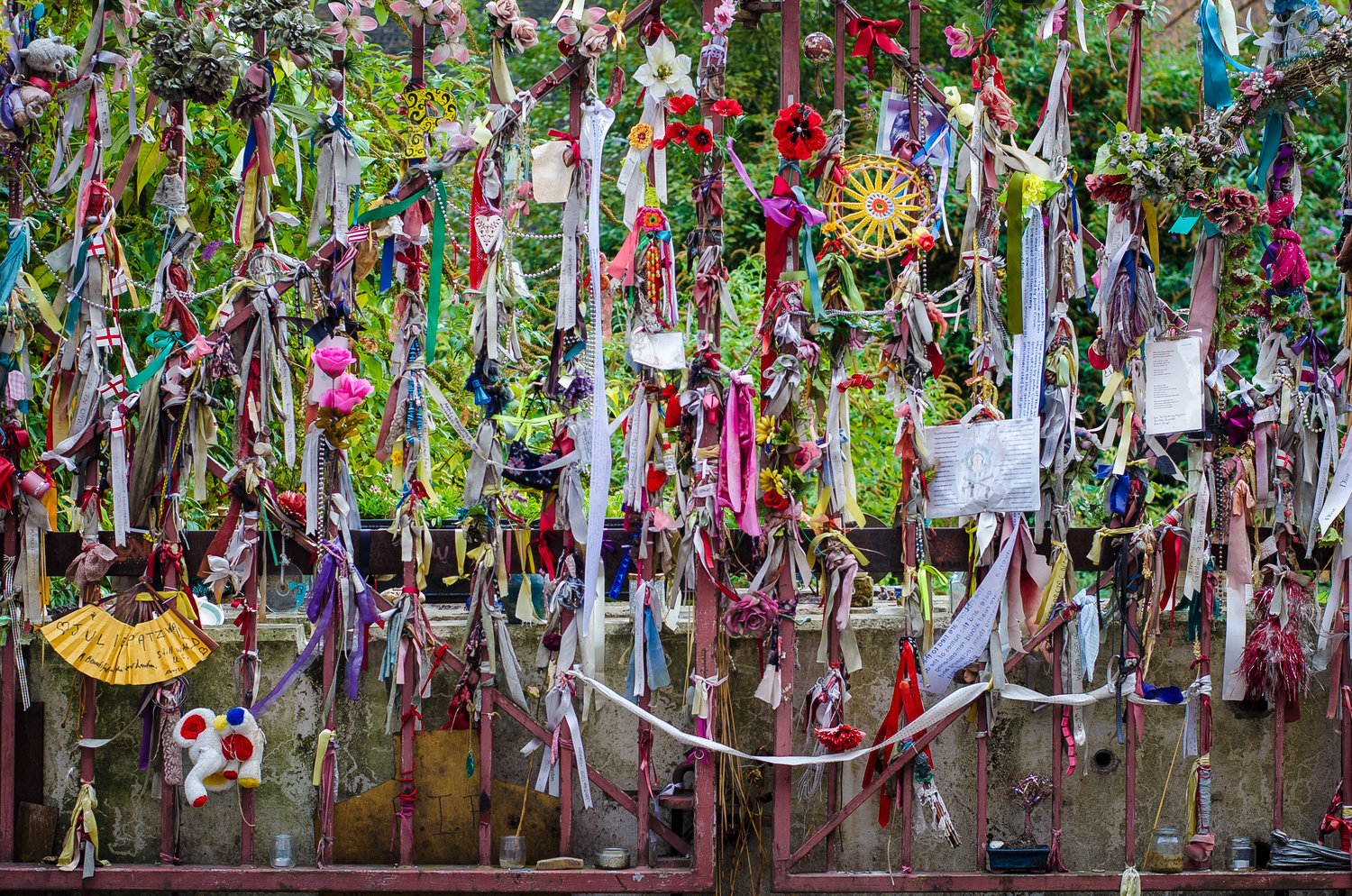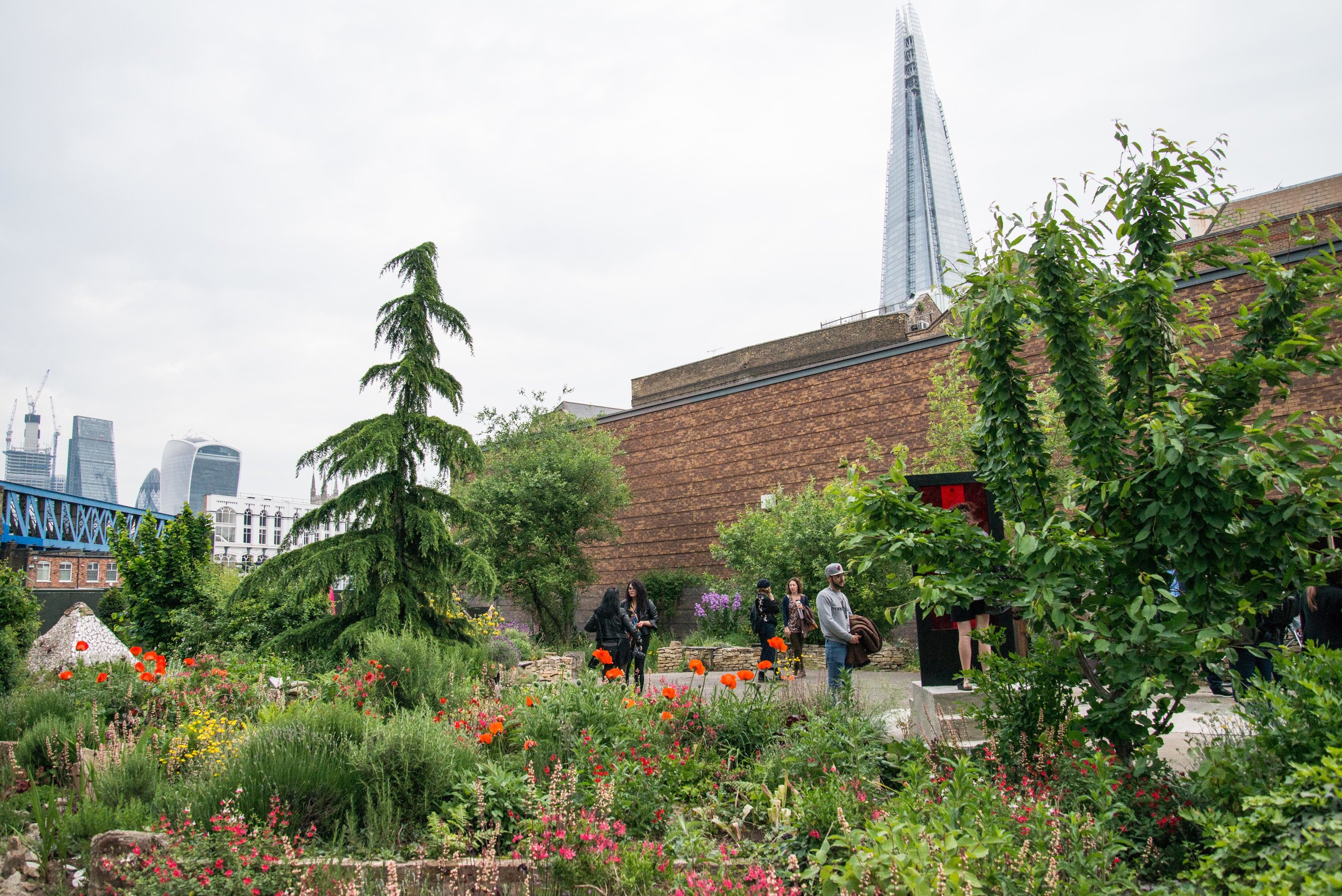
Crossbones Garden of Remembrance, 2012. (Photo by Gary Knight/CC License)
I first became fascinated by the role of individual narrative in monuments and memorials as I co-curated a project for Crossbones Graveyard in London in 2018. The tiny paupers’ gravesite contains approximately 15,000 bodies, primarily children and women, buried between the post-Medieval period and 1853. A number of those women are thought to have been sex workers, who, though licensed by the Bishop of Winchester to do sex work, were denied burial in consecrated ground. Located near London’s notoriously seedy South Bank, an area known for bear baiting, taverns, and brothels, the site became notorious for grave robbing and the ground so densely packed with bodies that some claim they were discovered a mere six inches from the surface upon excavation. In densely packed London, space was at a premium; for years the gravesite, sealed with lime mortar, played host to everything from workshops to fairgrounds. Rediscovered in the 1990’s with the construction of the power station for the Jubilee Line, the site currently features a garden overseen by Bankside Open Spaces Trust in conjunction with the Friends of Crossbones, who championed the preservation of the space, honoring those buried there.1
In my time at Crossbones, I found myself haunted by “The Crossbones Girl.” Unearthed in the 1990s in the archaeological dig that followed the graveyard’s rediscovery, her skeleton now resides in the Museum of London collection. The 17th Century woman died of advanced syphilis in her late teens, with her legs bowed from rickets. 2
Curators first included her remains in the 1998 exhibition London Bodies and then in the 2016-18 exhibition Skeletons: Our Buried Bones, which toured the UK. As one of the only Crossbones bodies that has been publicly visible, she has become a popular reference point for Crossbones wardens as well as a feature on handouts provided on site. In recounting her tale, Crossbones’ narrative frequently suggests the woman was likely prostituted as a child or raped by a syphilitic family member. Regardless of the truth of this tale, there is an implicit human logic to Crossbones’ positioning of “The Crossbones Girl;” the narrative of a single body can inspire a greater emotional resonance and connection than asking people to consider multitudes.
The 15,000 bodies, let alone the lives of those who dwelled in their bodies, of Crossbones cannot begin to be imagined in full. Mathematician Spencer Greenberg captures the limitations of human visualization of large numbers, noting that “we can easily visualize five things… We can even roughly visualize approximately 100 things — by, say, picturing a large crowd gathered.” 3
But at Crossbones, we are contending with 100 x 150 bodies, a large crowd of large crowds. The mind’s eye inevitably fails. A number of memorials make use of such an impossibility in visualization, directly and poignantly confronting us with quantities our brains are not prepared to handle. Peter Eisenman’s Memorial to the Murdered Jews of Europe in Berlin’s carefully arranged 2,711 concrete stellae leave viewers reeling as they are faced with the vast, horrifying scale of loss of life in the Second World War. Adding a layer of specificity through naming, Maya Lin’s Vietnam Memorial in Washington D.C., replete with the names of 58,318 fallen soldiers, leaves us both with the heartwrenching knowledge that each name means a family left behind and the sorrow that so many lives should be lost. The Kigali Genocide Memorial in Rwanda similarly provides a memorial wall of names of the deceased, while another section honors individual children, featuring their favorite toys and photos of the children. The names prevent each loss from being reduced to a statistic, allowing us to honor individuals even as we mourn a collective loss of life. Other memorials focus on a singular figure, channeling specificity into a profoundly touching representation. Mari Andriessen’s Anne Frank memorial in Amsterdam gives form to the girl whose words captured hearts around the globe, providing a singular captivating voice and figure through which to consider and grieve the atrocities of the Holocaust.

The opening event for the exhibition Outside at Crossbones Garden, a former paupers’ gravesite, 2018. (Photo courtesy of Sam Greer)
These memorial projects both are able to and need to contend with loss in a way that Crossbones cannot and does not. Unusually for a memorial, Crossbones focuses on those who died typical deaths and who had the opportunity to be mourned by their communities individually. First and foremost, this space was simply a graveyard for regular, impoverished Londoners. These are not lives lost to a specific tragedy that can be pinpointed in time. Yes, those buried over the centuries at Crossbones contended with institutional and structural violences, even in regards to where they could be interred, but there is no horrific event to caution against and to mourn. As opposed to the aforementioned memorials which call attention to violent events, for Crossbones there is less need to impress a sorrowful sense of quantity of those lost. At Crossbones, we do not grieve the scale of a singular tragedy, beyond the shared horrors of their packed interment in this space. Instead, Crossbones leaves us with an awareness of how systemic injustice has impacted communities for generations and how it continues to do so. 15,000 may be buried here and have been wronged by patriarchal and capitalist sensibilities that fueled their profound poverty, but that number is but a snapshot of one community over time. Furthermore, more recent memorials such as the Vietnam War Memorial and the Kigali Genocide Memorial often have access to more records as well as information provided by surviving loved ones, allowing memorial makers to incorporate the names and stories of the lives lost. Crossbones has no such resource, let alone a singular identifiable figure such as Anne Frank around which to focus its story. As a gravesite that is hundreds of years old, Crossbones primarily has skeletal remains for its principal resource, with sparse records. The predominant source of information is the bones themselves. While research into poverty, disease, infant mortality rates, and the Church of England’s historic attitudes towards sex work sheds light on the lives and deaths of community members buried here, the speculation derived from analysis of the skeleton of “The Crossbones Girl” is as close as we can get to any sort of particulars.
And so we are told the tale of “The Crossbones Girl,” creating a semi-fictional figure in light of the absence of definitive details. The story invites us to map a face onto her, to make her singularly ours in the telling of this story, thus avoiding asking us to contend with numbers beyond our imaginings. The site may not have many specifics to give us about her, but we create our own specificity through our projections. This tendency towards projection for unseen faces resonates with psychology professor Paul Slovic’s statements on the effectiveness of the photograph of three-year-old Syrian refugee Aylan Kurdi’s body lying on a beach: “we don't quite see his face, you see the side of his face, so you can project onto him the face of someone you know. You cannot distance yourself as easily.”4
For Slovic, such obscurity lends itself to a stronger sense of emotional resonance.

Detail of the shrine at Crossbones, 2016. (Photo by Aubree Penney)
Similarly, when we hear the tale of “The Crossbones Girl,” our minds project onto her skeleton, conjuring up an image. Though her bones are miles away from the garden in the Museum of London, a fleshly specter emerges. We paint lips, eyes, a skin tone in the hues of our choice; we envision the slope of legs curved by ricketts; we imagine her going about her daily life. Each time I hear about her, I see her twisting her hair with pale, thin fingers, mouse brown strands curling about her shoulders in the stifling heat of a kitchen in the London summertime. I see in her face a dozen faces I have known before: my sister, my undergraduate mentor, the woman on the bus, the man at the grocery store till; strangers and those I know and love well collide, forming a visage at once singular and ever shifting. My own memories rise up to meet her, to form her, and, in that very instant, she in turn becomes a part of me. In providing the impetus to imagine this body, strung upon a specific skeleton that exists elsewhere, Crossbones embeds the image of the woman, no matter how wildly inaccurately she might appear, in the minds of all who hear her tale, even if only for a moment. We cannot, as Slovic noted, “distance [ourselves] as easily.”
Crossbones, rather than utilize quantity or specificity, takes an approach driven by this imagination-fueled collapse of distance. The Crossbones team provides us with a figure who asks us to consider power dynamics, sexuality, poverty, and disease, a singular set of bones around which to wrap both one and a thousand stories. They issue an intimate invitation to draw from our own memories and our imaginations and fill in the blanks, bringing her into the present. We are asked to work for our connection, to employ our imaginations. In the absence of specific bodies and stories, we forge our own ties, engendering a new intimacy with both the memorial and its subject matter.5
